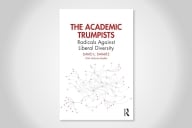You have /5 articles left.
Sign up for a free account or log in.
Scientists -- physicists in particular -- achieved a new kind of celebrity after atomic bombs exploded over Hiroshima and Nagasaki, Japan, in August 1945. “A few scientists were so confident of science’s supremacy that they openly relegated the arts to the past,” writes Peter Middleton early in his new book, Physics Envy: American Poetry and Science in the Cold War and After (University of Chicago Press). In his book, Middleton examines how poets viewed and navigated their own role in a society as science rocketed into cultural dominance after World War II.
Middleton is a professor of English at the University of Southampton, in England. He is the author of three scholarly books and a collection of poetry entitled Aftermath, and he is co-editor of the book Teaching Modernist Poetry. Middleton responded via email to questions about Physics Envy.
Q: In the book, you describe a change in the stature of science, physics in particular, and its relationship with the world of poetry after World War II. What happened and why is it significant?
A: The atomic bomb exploded. From that moment everyone became aware that the war had been fought by scientists as much as soldiers. Cryptography, cybernetics, penicillin, radar, weapons chemistry and other sciences, led by the hitherto esoteric theory of relativity and quantum physics, had made all the difference. Poets heard about the new physics on the radio, they read about it in the newspapers and Life magazine, and they became aware that nuclear scientists were claiming not only to know what the world was made of, [but] some, like Schrödinger, were claiming quantum physics could explain how life itself worked. Physics was in the ascendant, and the most prominent physicists, such as Oppenheimer, Heisenberg and Bohr were treated as important public intellectuals.
There was a dark side to physics, too. More than 100,000 Japanese civilians were vaporized in a mushroom cloud that soon began to hover spectrally over Cold War America. Were the physicists to blame for the threat, or were they containing it?
This history has a personal resonance for me. My parents met as wartime code breakers at Bletchley Park, and my father remained a cryptanalyst for most of his career, mingling physics, mathematics and language in his work. My mother has always been a keen reader of poetry. I studied both mathematics and literature at university. When I was boy, my father’s work twice took us to Washington, D.C., which in the ’50s and ’60s felt like the technological future compared to war-damaged Britain. Writing Physics Envy enabled me to revisit that period of history and explore the impact of the explosion of the sciences on our culture.
Q: Why was it important that poets find a way to clarify and change their relationship with science after the war?
A: Poets, readers of poetry and literary critics reacted strongly to these developments. Around 1950, critics published numerous articles and several scholarly books about the fraught relations between science and poetry. Was the scientific world mechanistic, faithless and amoral? The most distinguished of these critics, the Harvard mandarin Douglas Bush, warned, “All modern poetry has been conditioned by science, even those areas that seem farthest removed from it.” Were poets really being conditioned by the new sciences to the extent that they were helplessly behaving in the way that the sciences wished?
Poets themselves were intensely aware of these doubts and challenges. Almost all areas of interest to poets, the natural world, the emotions, history, even language itself, were now the domain of authoritative scientific inquiry. Did poets have to give up all claims to being knowledgeable in their role as poets, or could they claim that there was a different sort of poetic knowledge that also mattered? One solution that became popular from the mid-1950s onward was to turn to what only the poet could know, the inner world, and produce confessional, autobiographical poetry. Some of the most powerful science poetry takes this form. It asks: What place is there for me in this new scientific cosmos? A. R. Ammons, Alison Hawthorne Deming, Albert Goldbarth, Arthur Sze and many others ask such questions.
Q: So, what did they do?
A: They certainly didn’t give up on poetry. In Physics Envy I concentrate on poets in the modernist tradition who, in Muriel Rukeyser’s words, decided to test the “methods of science” rather than simply to be commentators on other people’s knowledge. These poets wanted to join the scientists out at the so-called frontiers of knowledge, have a look round at the marvels there, perhaps even make a few discoveries themselves. I tell two main stories about these poets.
Charles Olson’s 1950 manifesto “Projective Verse” proclaimed a new kind of poetry, “composition by field.” If the field concept was one of the best tools physics had for understanding the material world, perhaps its leverage could also be applied to poetic inquiry. The story I unearth is that his confidence in the field metaphor was founded on a conviction that poets could avail themselves of the latest methods of scientific inquiry, the use of conceptual schemes (constructs or provisional models) just as the social scientists were doing. Doing this proved a struggle for Olson, which is visible in the first phase of his long epic poem about the origins of America, “The Maximus Poems.”
The other story I tell is about how several very different poets -- Jackson Mac Low, Amiri Baraka, Robert Duncan, George Oppen and Rae Armantrout -- responded to the versions of science circulated by Scientific American. It might have been a drug-store magazine but in the ’50s and ’60s it was read as much by the professionals as by the public. Bulky issues full of recruitment ads and publicity for everything from lab gear to nuclear subs provided a compelling backdrop to informative articles. Poets dug into the magazine, spliced and sampled it, inventively rearranged its vocabulary, argued with its vision of humanity, challenged the reliance of urban scientists on technological solutions to political problems and cried out at the toxicity of the recurrent publication of would-be liberal “race” science claiming to be as scientific as physics.
Q: The book focuses on more than just poets incorporating or addressing science in their poems, but also the broader issue of scientific vs. poetic inquiry. Can you briefly describe the kind of inquiry you're writing about and what poets had to learn from scientists about it?
A: Scientific research is one of the best methods that humans have ever found for learning how the world works. But science is not the only trustworthy way of doing this. There are other valuable ways of being curious, of investigating the causes and consequences of phenomena, of reflecting on how we think, feel, imagine, theorize, communicate, remember and foretell. I use the term “inquiry” to point to some of the features that scientific research and the arts can have in common -- curiosity, discovery, rigor, reflexivity, communicability, even testability -- as well as to invite thought about the differences. I think of the continual inventiveness and observational attentiveness of modernist poetry until the present day as a striving to keep poetry on the inside of policy and knowledge making in an era when politicians and some scientists have wanted to bar the door to artists and poets.
Encouragingly, I found that the physicists in the postwar era were far more interested in poetry than I had imagined. Serious science journals ran articles about poetry, physicists mentioned poetry in conference addresses, the older generation openly discussed poetry in their books and the younger generation more quietly invoked analogies with poetry to explain difficult issues of the quantum universe.
Q: Before poets got there, though, the social scientists did. Can you briefly describe the social sciences’ relationship with physics at the time and what elements the former adopted from the latter?
A: As I set out to write the book I assumed that when Charles Olson insisted that the poem should be a “high-energy construct,” or Amiri Baraka claimed that African-Americans were “defying physics,” or George Oppen talked in his poems of the “mineral” world, or Rae Armantrout questioned the metaphor of “system,” they were referring to physics. Gradually I came to realize that what I was seeing was part of a much bigger picture. From the late 1940s to the 1970s, everyone wanted a share of the epistemic glamor of physics. Physics appeared to be the best model of knowledge. Psychologists, sociologists, biologists, philosophers, economists, literary theorists and linguists all incorporated physics analogies and metaphors into their research methods in the hope of making their work more scientific, more rigorous, more up-to-date.
I trace a specific history of social science back to the 1930s, building on the work of Joel Isaac’s insightful study “Working Knowledge.” He shows how the Harvard social scientist Lawrence Henderson spread the idea that, if sociologists and psychologists wanted to be taken seriously as scientists, they had to learn to construct theories more effectively. They had to construct what Henderson first called “conceptual schemes,” localized models of some specific social phenomenon that could then be tested empirically and revised as necessary. Henderson suggested that social scientists look for ideas of how to do this [in] the work of Willard Gibbs, the 19th-century American physicist of gases and statistical mechanics.
The poet Muriel Rukeyser was so impressed by the idea that Gibbs had laid the foundations for a new scientific study of social life, she wrote a cultural biography about his contribution to American history and later proposed that if poets learned to think like Gibbs and the social scientists and construct what she called “systems,” they too could use the “methods of science.” Olson shared this interest in scientific method, though to him the field concept looked more fertile. Most readers have agreed.
Conceptual schemes went on to bigger things in the work of Thomas Kuhn, Wilfrid Sellars and cultural theorists. Conceptual art and now conceptual poetry spring from this history.
Q: What are the lessons here for scientists and poets today?
A: I wouldn’t want to tell scientists or poets what they should be doing! Both poetry and the sciences have changed considerably since the period I discuss. Marina Warner says that “materialism’s long history has rendered matter itself insubstantial: physics has brought a new metaphysics into being.” Physics alters our sense of self, substance and what is fundamental. Poets continue to be fascinated. This past week I joined a wonderful Poets & Critics [a symposium and research project] workshop in Paris with the poet Fred Moten -- he finds the latest physics fascinating in itself, and images of such processes as quantum entanglement help him think in new ways about complexity in poetry, music and social relations. The British poet Allen Fisher has written poems about life in a Brixton housing project that so widely encompass contemporary knowledge and experience that even quantum physics turns up on the doorstep. Like other contemporary poets, they assume that an inclusive contemporary poem has room for quarks and jazz.
Physics Envy suggests several topics that might interest scientists and poets today. Late in his career, Robert Oppenheimer encouraged fellow physicists to communicate to the public more of the raw poetic energy they create within the intense debates of a research community. Other physicists, such as Heisenberg, Schrödinger and Gell-Mann, found sustenance in poetry. The history I uncover also reveals that it matters to poets how professional scientists think about poetry: the scientific image of what poetry can and can’t do is part of the expectation in which poets have to work.
Q: And what about readers who may not be scientists or poets? What do you hope they take away from your book?
A: Let me start with the title. The idea of physics envy began to circulate in the early 1970s. Although it perfectly sums up the rush to use physics analogies that gave rise to uneasy questions about authority and a threat of mockery, I wondered if I should use such a negative word as “envy,” not to mention the Freudian joke. Would potential readers think I was shaking my head at the folly of poets and intellectuals?
I wrote the book because I believed that science doesn’t have a monopoly on worthwhile research. Even poetry can be a form of inquiry leading not only to discoveries about language, the self, memory, history, society, but also the living world and the material universe. Such inquiry requires dialogue with the sciences, and these conversations may well start with the kind of admiration that leads to physics envy -- or psychology envy or even poetry envy. Of course poetry is an immensely diverse activity, but this capacity of its art is too often overlooked.
Let me admit to a bigger ambition. Too often, interdisciplinarity either means that one discipline defers to the authority of another, or alternatively that the discipline claiming interdisciplinarity, instead of going out and actually talking to active specialists in other disciplines, has a largely internal conversation about what it just assumes are the core issues within another field. How can we have more genuine dialogues across the many fields of knowledge and art? Crucial to such new exchanges would be a mutual respect for the professionalism and epistemological integrity of each other’s modes of inquiry and knowledge, whether physicist or poet. The history I tell shows that at their best that is what the physicists and poets achieved.








